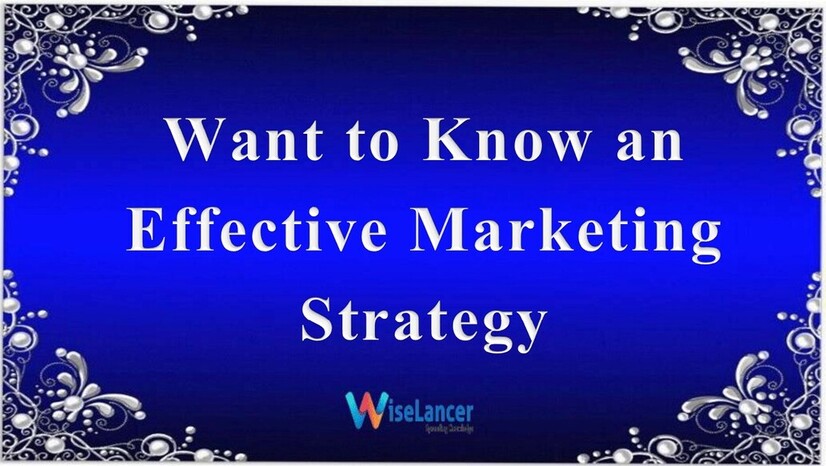Want to Know an Effective Marketing Strategy. Please read the guide to implement an effective marketing approach to achieve the desired result.
Summary:
What is a marketing strategy?
Why develop a marketing strategy?
The different marketing strategies
How to make a marketing strategy?
Marketing trends of recent years
Examples of successful marketing strategies
Launching a new item or product or entering in a new market should leave nothing to chance. A good marketing strategy must serve to maximize the company’s chances of success and lead it to new development opportunities. This marketing guide helps you define and implement an effective marketing approach.
It is not easy to convince a customer that a product is best for him, just as it can be complex to find a place in a particularly competitive market. In pursuit of its objectives, an organization must be able to define a relevant and coherent approach to the market, seeking to maximize the chances of success. From design of the product or service to the enhancement of its main assets, through the definition of its price, its distribution on the market, nothing should left to chance. The approach to a market must translate into a thoughtful and appropriate marketing strategy.
What is a Marketing Strategy?
A marketing strategy will define a set of methods and actions. Its implementation to enable a company to achieve its sales objectives on the scale of a given market, in particular by seeking the best match between the offer and target customer demand.
The marketing strategy integrates many variables, such as price, product quality, market needs, competition, and seeks to adjust them to convince customers of the relevance of a product, to differentiate it, to establish a brand. at the heart of a given territory or vis-à-vis a targeted population.
It is she who notably defines the specificities of the product or service, in other words its value proposition, by considering the needs of the clientele. It sets the level of quality and the price, the services associated with the offer with the desire to ensure customer satisfaction.
By constantly questioning the market, trends, competition, risks and opportunities, it evolves with the ambition of increasing sales with regard to the objectives pursued by the company.
The marketing strategy also integrates the logistical issues of production, distribution of the product or service, the opportunities for expanding the market and the possibilities of achieving economies of scale.
The marketing strategy designates a structured approach that intrinsically linked to the business strategy and its organization, with the aim of supporting its sustainable development.
How to evaluate the digital experience provided by your company?
Download this free guide and conduct a comprehensive digital experience audit to improve your online interactions with your audience.
Why Develop A Marketing Strategy?
A company evolves within a market where it finds its acquired or potential customers and its competition. The first reason why a company develops a marketing strategy must therefore be to meet the formal and informal requirements of this market.
There are many other good reasons to implement a marketing strategy. Such an approach can pursue extremely varied objectives. We picked up a few.
Ensure the visibility of the product:
Once the qualities of the product or service have been determined, a marketing strategy will seek to implement various means to ensure its visibility and bring the offer to the attention of a targeted audience.
Attract and Convince The Customer:
Thanks to a good understanding of the customer’s expectations, the marketing approach will develop the most suitable arguments to seduce and convince him.
Stand Out From The Competition:
At the heart of a given market, the planned marketing approach must also make it possible to stand out from the competition, by asserting or developing competitive advantages.
Improve the Company’s Image:
The marketing strategy must be part of a long-term approach, with the desire to strengthen the company’s brand image with various consumer segments.
Develop New Business In New Markets:
Through a well-structured and coherent marketing approach, the company can approach new markets in a relevant way. A good knowledge of consumers and their needs also makes it possible to redirect offers or propose new ones.
Seek Economies Of Scale:
the marketing strategy is developed to enable the company to take advantage of economies of scale, by pooling the costs of designing and developing the offer, as well as advertising efforts in several markets by example. On the other hand, while seeking the best balance between supply and demand, the marketing strategy makes it possible to reduce costs and optimize margins.
The Different Marketing Strategies
Concentration strategy
Differentiation strategy
Skimming strategy
Penetration strategy
Several major marketing strategies can be distinguished.
The Concentration Strategy:
This marketing strategy is usually implemented when the brand only targets a single customer segment. It also referred to as a focus or specialization strategy. All the efforts undertaken are intended to convince and retain a very targeted clientele.
This approach to the market implies having a real competitive advantage, linked in particular to the cost or specificities of the product, which it is important to preserve and strengthen over time.
It is a marketing strategy often adopted by players in the luxury industry, but also by many small and medium-sized companies, which launch with a single product or a relatively limited range.
There are many examples of companies using the concentration strategy. This is particularly the case when a fashion brand decides to focus on a very specific clientele, such as heavier women. This is also the strategy that will often be favored by a shop specializing in a product, such as tea or chocolate, with the desire to address tea or chocolate lovers as a priority.
The advantage of a specialization strategy lies in the in-depth knowledge that the company has of the product, of the customer, of the market. It most often allows you to stay one step ahead, to follow trends closely and, sometimes, even to define them. It can also more easily retain a clientele largely made up of real fans. This strategy makes it possible to reduce costs with, for example, easier inventory and supply management or larger orders of specific products giving rise to discounts.
The major drawback of such an approach lies in a possible evolution of the market on which the company is extremely dependent.
The Differentiation Strategy:
Unlike the first, the company that adopts a differentiation strategy addresses several market segments, seeking to distinguish itself from its competitors, and not a very specific target.
With this marketing strategy, the desire is to work on the quality of the products and services offered in order to stand out from the competition.
A chain of supermarkets, for example
A supermarket chain, for example, can emphasize the integration of a range of healthy products at the heart of its shelves and, on the other hand, offer a loyalty program that is more attractive than that of its competitors.
Depending on the activity, differentiation can take place on the ability to innovate, on a more efficient use of raw materials or technology, on the development of additional services associated with the offer, such as quality after-sales service or a personalization of the customer relationship.
With such a strategy, the company seeks to develop and preserve a competitive advantage, but also to make it difficult for players capable of gaining market share or replacing it to emerge.
Two Major Forms Of Differentiation Strategies Must Be Distinguished:
Differentiation from above: the company offers a more complete offer, with better quality than that of its competitors, with the desire to generate greater value perceived by the consumer. In this way, she can increase her selling prices.
Bottom-Up Differentiation:
The company offers a less complete offer, but at a lower price. This price difference should attract more customers. This is the strategy operated by firms that practice low cost.
Skimming Strategy
Skimming is a marketing strategy that aims to position itself on the market with a higher price than that practiced by the competition, with the desire to reach a specific customer segment with greater purchasing power.
To achieve this, the company must be able to assert a competitive advantage over companies in the same sector. It must be tie up, for example, the quality of the product offered, in the notoriety of the company, in the image and the universe associated with the product. In general, the skimming strategy implies that the brand is well established in the market and enjoys significant notoriety.
This approach is implemented in the context of the launch of a new product, most often eagerly awaited. Upon release, the company offers it at a higher price than only first-time customers are willing to pay. These customers have developed a very strong attachment to the brand. For example, it’s Apple customers who want to be among the first to buy and test a new product, even if it means long hours in line.
By using such a strategy, the brand can maximize its profits by selling its product at a higher price than what the average consumer would be willing to pay. It first affects those who are ready to pay more than others, taking advantage of a large margin. Then the skimming strategy provides for the gradual reduction of this price over the life cycle of the product, to reach other customer segments. Indeed, as its costs decrease and the investments related to the development and launch of the product reduced, it will gradually go to meet a much larger market by reducing prices while maintaining its margin.
The Penetration Strategy
This marketing strategy, as its name suggests, implement it to penetrate a market. It opposes the skimming strategy by seeking to offer a product that meets the expectations of the greatest number, at a generally attractive price, on the widest possible market.
With this strategy, considered aggressive, the company’s desire is to quickly gain market share from the competition. It initially implies a policy of low prices, despite major investments in distribution, advertising and sales. By breaking the market, the company makes a place for itself with a view to settling there permanently and possibly reassessing prices upwards in a second stage.
The use of this strategy is often illustrated with the arrival of a new telecommunications operator on a market. To win customers, even if the service is not always there, the company offers an offer at a bargain price, with the aim of establishing itself permanently in a landscape often considered to be extremely competitive.
How to Make a Marketing Strategy?
The marketing plan must be considered in a structured way, between strategic approach and tactical elements, to guarantee a coherent approach to the market. It starts from an analysis of the context, takes an interest in the potential clientele to arrive at an ideal positioning of the offer through a value proposition.
Here are the main steps allowing you to establish your marketing strategy and make it evolve over time:
Analyze Market Opportunities
A marketing strategy is directly linked to the company’s objectives and must translate its ambitions on a market scale. Its establishment is based primarily on the opportunities that arise. The brand must consider threats and opportunities, its strengths and weaknesses, as defined by the SWOT model (Strenghs, Weaknesses, Opportunities, Threats).
These elements can be of different types. They can be linked to the intrinsic characteristics of the company, such as its size, its skills, its means of production, or even its distribution network in a given market, its product, its competition. Other opportunities or threats will depend on the socio-economic context, regulations, culture, etc.
The analysis can be translated through a market study, more or less advanced. Based on the elements revealed, it should make it possible to approach the market with full knowledge of the facts and to define a coherent approach to penetrate or strengthen it.
Through market research, the various customer segments, their size, their resources will thus be identified and analyzed.
Target Customers
Once you anlyze the market, it is important to be able to target the clientele and their needs.
Who Do We Want To Contact? What Can We Offer Him?
The same offer, product or service, can respond to several groups of prospects, some with different characteristics from others. For example, a group of young consumers certainly does not share the same concerns as a group of seniors. And yet, both will need a pair of shoes to walk, a car to get around, clothes to wear. They will all feed the desire to go out, to meet people, to go to the cinema.
To target customers, it is necessary to bring together people with similar consumer behavior within the same group.
It is interesting to extend this analysis beyond the potential end user of the product.
In this targeting process, it will be interesting to consider other profiles:
The Buyer:
Who is the person who buys without necessarily being the recipient of the offer. If the end user is a child, the buyer is most likely to be their father, mother or another acquaintance. A gift will never be acquired directly by the recipient, but by a third party, a relative or a friend, who wishes to please someone around him.
The Prescriber:
This is the person who prescribes a service or product to the buyer. For example, a healthcare professional may recommend that a patient enroll in Pilates classes to build strength. The doctor is then the prescriber. The role of the prescriber, because of his strength of recommendation, can be of great importance to establish oneself on a market.
Each target can be translated into a persona. This is a fictitious profile that takes up the characteristics specific to each target, but also the context in which they live, their expectations and desires, their tastes, their purchasing power, their consumption habits. It is a reference profile on which we can rely to build an appropriate marketing approach.
Position the Offer Well
Once the clientele has been targeted, the challenge is to successfully position the product or service with regard to everyone’s needs. It is then a question of establishing a value proposition.
Starting with the customer’s needs and expectations, adopting the consumer’s perspective, it is a question of promoting to him the advantages and benefits that the proposed offer will confer on him.
If the value proposition must convince users, it must also allow the company to position itself vis-à-vis the competition. It is about enhancing the attributes of the product or service that will make it unique on the market and that will give it an advantage over competing offers.
A Good Positioning Must Meet The Following Characteristics:
Explicit: it must be able to directly perceived and understood by all the targets
Different and relevant: it must make it possible to distinguish you from your competitors while best meeting the expectations of the targets.
Fit into a given context: take the market into account, integrate cultural elements, surf on current trends.
Define an action plan or the “marketing mix”
Once the targets have been determined and the value proposition(s) established, the marketing strategy consists of an action plan to allow the company to penetrate the market or to strengthen itself there.
This action plan, also called marketing strategy, translates through the marketing mix.
It is based on four main components:
The product policy:
Which defines the particularities of the product, its functionalities, its quality and its robustness, etc.?
The pricing policy:
It aims to establish the right price, considering what the consumer is willing to pay, the costs inherent in the product or service, the margin.
The communication policy:
It describes the means to be implemented to promote the product or service, to bring it to the notice of the consumer and convince him.
The distribution policy: it sets the method of distribution of the product or service, for example the network of points of sale, the supply chain of distribution, etc.
Increasingly, marketers consider three other factors complementary to the first four:
People:
The members of an organization who, united around a strong corporate culture, are the primary ambassadors of the product or service they promote.
Processes:
The way of producing and delivering a product or a service to a company’s customers, ensuring quality and efficiency.
The physical environment:
Ensure that all the physical elements that support interaction with customers, such as the atmosphere of the premises, the packaging of a product, the design of a website.
All of these components are interdependent. Increasing the quality of a product will, for example, lead to an increase in price and will have an impact on distribution, the target clientele being smaller.
The marketing strategy must adjust all the variables to define a coherent action plan, in line with the company’s objectives and the customer’s expectations.
Control and adapt the strategy
The marketing strategy must also provide for the means for the implemention to assess the relevance of the actions planned over time. Beyond monitoring sales and return on investment, it is especially important to measure the effectiveness of the processes put in place, to ensure optimal distribution, to control the level of customer satisfaction or to be able to assess the brand awareness among target consumer groups.
By carrying out checks thanks to the implementation of various indicators (KPI). The company can detect new levers for improvement. The activated elements help to get closer to the market and customers and meet their needs. .
Assessing the relevance of actions and regularly surveying consumers can also be a source of new opportunities for the company. Going to meet new customers and seek to meet their specific needs can lead to new development projects.
The market, like the objectives of a company, is constantly changing. Control makes it possible to detect these trends, to anticipate changes in the offer and to adapt the strategy if necessary. A good understanding of the market also makes it possible to assess the margins of progress and to consider the actions to be taken to move forward. Depending on the situation, the company can consider new approaches; consider expanding into new markets, through the implementation of an internationalization strategy for example, or even co-branding actions to reach out to a new customer segment.
Marketing Trends in Recent Years
In recent years, various trends have driven the world of marketing, forcing professionals to integrate new approaches into their strategies. Mainly technological developments are shaking up habits and have a great influence on consumer behavior.
Indeed, between structural transformations and fashion effects, the hardest part is to make sense of things. However, it is necessary to adapt ever more quickly, by being open to novelty with the desire to remain as close as possible to consumers.
Digital Transformation is changing the Consumer Journey
It seems a long time ago when the family gathered in front of the same television set to watch the evening news and watch the string of advertisements that followed one another before and after the news. The digital transformation has profoundly changed our lives, offering us the possibility of obtaining information much more easily online, of making our purchases on the Internet, of interacting with each other on social networks.
These developments have profoundly changed the path to purchase, but also the interactions between a brand and its customers.
The marketing strategy must now include a digital component, to guarantee the brand online visibility and a strengthening of its notoriety via digital channels. She can consider digital sales opportunities or paths starting online and continuing in store.
Today, the concept of digital marketing includes all the techniques used on digital media and channels to promote products and services.
Social Media Marketing, To Exchange with the Customer and Combine a Community
In a few years, social networks have emerged as dominant platforms in the media landscape. If they make it possible to connect individuals, to share content between people sharing the same centers of interest, they also offer opportunities for brands to build relationships with the consumer, to federate their customers in a community.
Social media marketing brings together approaches and techniques to implement, maintain and develop a coherent approach to serving the brand on social networks. One of the first challenges is to establish a relationship based on exchange, discussion, co-production of ideas, with the consumer. Social platforms are also an entry point into the buying journey.
It is with the emergence of social networks that the function of community manager has become popular.
Mobile Marketing, To Maintain the Link Permanently
If the emergence of the web has transformed the way of apprehending marketing, the evolution of mobile terminals offers the possibility of going even further and of considering new modes of interaction with the customer, wherever he is at any time.
Today, four billion people in the world use a telephone. A quarter is using smartphones. We use our mobile phone more than our computer.
Mobile marketing considers all the practices that make it possible to strengthen the link between a brand and the consumer by relying on the possibilities offered by mobile technology. The marketing strategy can integrate a high level of personalization of the relationship, relying in particular on the data transmitted by the user.
It integrates new communication channels: such as the mobile application and notifications, SMS, MMS, geolocation solutions. It allows, more and more, transmitting the right and clear message, to the right people at the right time.
Content Marketing, To Arouse the Interest of the Consumer
Content marketing is not something new. Behind this concept, there is the idea of providing quality, non-commercial content related to the consumer’s interests to maintain the link and indirectly serve the interests of the company. The famous Michelin gastronomic guide, for example, stems from a content marketing initiative launched by the tire manufacturer of the same name. At the time, the firm in Bibendum had the idea of offering a small publication to its customers wishing to travel through the countryside with their beautiful car fitted with new tyres. It included technical recommendations, but also tourist ideas and good restaurants to discover.
Content marketing has recently been brought up to date, with the emergence of the web and even more so of social networks. From then on, the consumer proved to be less receptive to advertisements insofar as everyone was able to choose the content they wanted to consume, and when they wanted to do so. Advertisers have therefore had to adopt other approaches in order to offer content more in line with consumer expectations and, in this way, maintain the link and strengthen their online visibility.
Today, content marketing includes methods and techniques to strengthen the positioning of a brand through the design, production and distribution of text, visual, audio or video content.
Inbound Marketing, To Attract Customers and Retain Them
Inbound marketing, an extension of content marketing, is based on a content creation strategy that attracts visitors and then converts them into leads and then into customers.
It opposes outbound marketing, a concept used to qualify the use of non-targeted and intrusive advertisements. With inbound marketing, the idea is to establish a first contact with the consumer by offering him content related to his centers of interest or his concerns, but having no commercial vocation. Through the implementation of a conversion tunnel, the desire is to maintain this link over time, by offering to regularly receive value-added content that could interest him, and in this way to bring him to consider an offer of services or a product in line with their needs.
Inbound marketing also implements other elaborate techniques to accompany the customer throughout his online journey and guarantee him an optimal experience. We can notably mention, beyond the creation of content, marketing automation or lead nurturing, engagement on social networks or even blogging.
Influencer Marketing, To Rely On New Ambassadors
With social networks and content platforms, from Facebook to TikTok to YouTube, new personalities have emerged. Today, brands do not hesitate to rely on their power of influence to promote a product or reach well-defined audience targets.
Influencer marketing lies in the implementation of studied approaches to increase brand awareness through these influencers. The brand can, for example, try to convince an influencer with whom it has common values to talk about its product, through commercial agreements. In other cases, it can develop more structured approaches to the co-creation of content or even products, in a co-branding approach for example, with a prominent personality.
Neuromarketing
Recently, marketing professionals have taken an interest in neuroscience, with the desire to better understand, predict and influence the emotions, choices, likes, dislikes and behaviors of consumers. This is what is known today as neuromarketing. Thanks to the identification of neural mechanisms, such as the activation of specific brain areas, this emerging discipline makes it possible to study precisely the effects of an advertisement, message or packaging, but also the design and the structuring of a web page on the consumer. In this way, it is possible to considerably improve the tools of persuasion of the consumer.
Examples of Successful Marketing Strategy
Here are 4 examples of a successful marketing strategy:
Leroy Merlin

Leroy Merlin, a brand specializing in DIY, has decided to implement a content marketing strategy based on videos devoted to his chosen field. It is aimed at experienced DIYers as well as novices. These videos are very popular with the public. In addition, Leroy Merlin offers a tutorial platform that always provides more advice and best practices so that its customers are independent during their work. This marketing strategy thus builds customer loyalty and attracts prospects by positioning the brand as an expert.
Nike

Nike, the famous sporting goods brand, focuses its digital marketing strategy on content quality and not quantity. Indeed, Nike publishes four contents per month. However, the brand is very responsive on social networks and uses Twitter to manage its after-sales service. The majority of Nike publications accompany major omnichannel advertising campaigns. It uses paid advertisements and appeals to major influencers.
HootSuite

HootSuite offers a social media management solution. This brand has developed a marketing strategy that has generated very positive results. The HootSuite teams are “Game of Thrones” fans. They were therefore inspired by the credits of the series to create a video. This video also makes the link between the series and the brand’s products. To have more impact, HootSuite timed the release to coincide with the airing of the first episode of a new season of the series.
Sears

Sears, a large distribution group in the United States, has developed the “FitStudio” site specializing in the field of fitness. Experts in this discipline offer content with high added value. Internet users interact, comment and share them. Sears then measures the positive effects of its campaigns with the tools at its disposal on social networks. The content is sponsored traditionally, but also on the various Sears platforms.
To go further in your marketing strategy, download this free guide and carry out a complete audit of the digital experience provided by your company to improve it.
Need Help or Advice in Content Management:
Would you like more advice? Do you have good practices to share? Express yourself in the comments.
Also, if you want help writing content to drive more traffic and boost conversions, please get in touch through Contact our team.
Do you want help writing quality content, driving traffic to your website, and boosting conversions? You can contact me through my Freelancer.com profile also. I always prefer to work through Freelancer.com for smooth functioning. Here you pay safely and securely.
Read More:
BEST TIPS FOR MIXING SALES & MARKETING A BRAND | OPPOSITES ATTRACT
WHAT IS ETHICAL MARKETING | ITS IMPORTANCE, ROLE WITH EXAMPLES
NINTENDO SPECIAL MARKETING APPROACH | HOW IT DEALS WITH MICROSOFT AND SONY?
